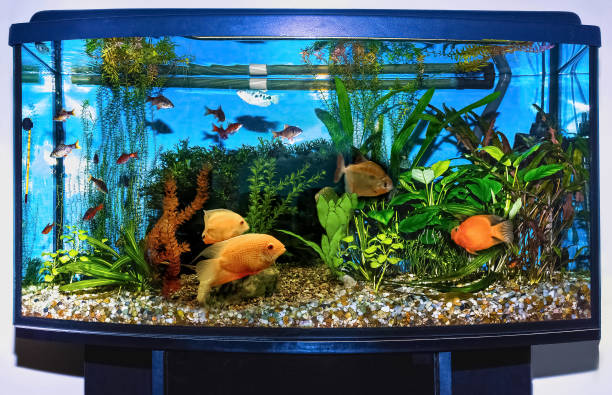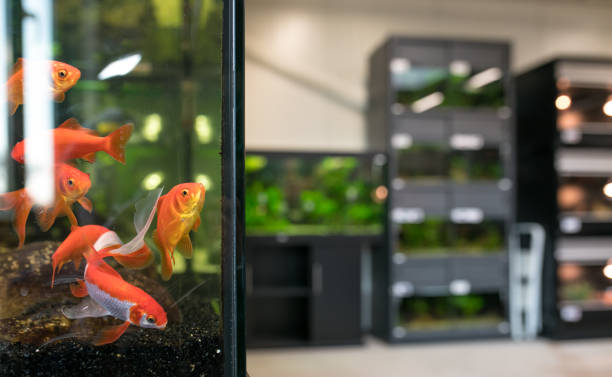Why Do My Fish Stay at the Bottom of the Tank
Most fish in an aquarium swim to find food or to entertain themselves. Most of the time, fish will rest near the bottom of the tank more often and the reason varies in every circumstance.
Some fish, like goldfish and koi, naturally stay near the bottom of a tank because it is where they feel safe. Other fish, like cichlids, may stay near the bottom because it is where they feel most comfortable eating. Your fish staying at the bottom of the tank might also indicate danger. Some fish, like barbs, may stay near the bottom because they like to hide.

Table of Contents
Normal Reasons Why Fish Lay at the Bottom of the Tank
There are many normal reasons why fish may lay at the bottom of the tank. Some fish may be resting, others may be hiding, and still, others may be trying to find food. It is important to remember that not all fish will lay at the bottom of the tank, and some fish may even swim around more than others. Here are some of the causes why your fish stays at the bottom of the tank, reasons where you don’t need to worry about.
Your Fish Is a Naturally Bottom Dweller
Many bottom dwellers will lay at the bottom of the tank. Fish like loaches, Corydoras, and plecos usually stay near the bottom because it is where they feel safe from others. Some fish like Oscar may swim around more but will always find a spot to rest near the substrate. Fish that is bottom-dweller typically stay at the bottom of the tank because it is a safer place for them. Fish that live in the water column are at risk of being eaten by predators or getting caught in nets. Bottom-dwelling fish also have less exposure to pollutants and other dangers that can be found in the water column.
Your Fish Is Resting
Some fish may lay at the bottom of the tank when they are resting. When a fish is tired, it will usually rest near the bottom of the tank where it can get some peace. Laying at the bottom of a tank doesn’t always mean that your fish is in danger, but you should still monitor your pet closely to make sure everything is okay. Some signs that your fish may be in trouble include not moving around much or being lethargic.
Your Fish Is Aging
Older fish will typically lay at the bottom of the tank to rest. As fish get old, they may start to lose mobility and balance. Laying at the bottom of the tank gives them a stable position in which to rest. Older fish also tend to have more sluggish movements and may not be as active as younger fish.
Aquarium Size
One of the most common reasons why fish will lay at the bottom of their tank is because they are overcrowded. When there are too many fish in a small space, they will start to compete for food and resources. This can lead to territorial disputes and ultimately stress for the fish. If you find that your fish is laying at the bottom of its tank more often, it may be best to add space for them to live.

Unusual Reasons Why Fish Lay at the Bottom of the Tank
On the other hand, there are also reasons why fish lay at the bottom of the tank where it needs your attention and in grave cases, even medication and a check-up to your veterinarian.
Stress
Many fish that live at the bottom of a tank are there because they are stressed. Fish can be stressed in many different ways, but one common cause of stress is when the water quality in an aquarium changes dramatically. When this happens, it can be difficult for bottom-dwelling fish to find food or safety. Bottom-dwellers may also congregate near the bottom of a tank if they feel threatened or scared by other fish.
External Fish Stress
External fish stress is a term used to describe any type of stress that a fish experiences from the environment outside of the tank. This can include things like overcrowding, poor water quality, and temperature changes. Fish that experience external stress are more likely to develop diseases and problems, and may even die.
Internal Fish Stress
Internal fish stress is a term used to describe several different problems that can occur inside the fish’s body. These problems can range from minor issues, like a fish that is eating too much or staying in one spot too long, to more serious problems, like a fish that is gasping for air or has white spots on its body. Fish that are experiencing internal stress are often reluctant to move around or explore their surroundings. They may also show signs of being sick, such as swimming in circles or having a decreased appetite. If left untreated, internal fish stress can lead to death.
Poisoning
One of the most common causes of fish resting at the bottom of tanks is ammonia poisoning. Ammonia smells like rotten eggs and is produced when organic matter, such as fish poop, decomposes in the water. Too much nitrogen in the water can create a toxic environment that harms both your fish and plant life. Nitrate poisoning can also be a cause of fish death in tanks. Nitrates are found in many plant-based foods and water treatments, such as fertilizers and chlorinated water. When these substances are broken down by the bacteria in your tank, they can form dangerous nitrite levels. Too much nitrite is toxic to both fish and plants.
Too Much Light or Heat
Lightning and high temperatures can also be harmful to your fish, especially if they are not properly equipped to handle those conditions. Prolonged exposure to light or heat can damage your fish’s eyes, skin, and internal organs.
Excessive Current
If you live in an area with strong currents, your fish may be struggling to survive due to the drag it creates. A strong current can also sweep away your fish if it is not properly secured in its tank.
Unstable Temperature
Fish can sense water temperature and use it to determine whether they should swim or stay put. When the water is too hot, fish will swim away from the heat and will just lay at the bottom of the tank. Another reason fish stay at the bottom of the tank is that the water is too cold. When the water is too cold, fish cannot swim and will stay near the bottom.
Swim Bladder Disease
Swim bladder disease is a common fish health issue. It can cause fish to stay at the bottom of the tank, lose weight, and develop a cloudy or bloody appearance. Swim bladder disease is often caused by a lack of oxygen, parasites, or poor water quality. Treatment usually involves antibiotics and a change in water conditions.
Sickness & Disease
Many fish diseases and sicknesses are easily preventable. Poor water quality, overcrowding, and bad tank conditions can all lead to disease. Make sure to keep your fish tank clean and healthy by maintaining good water circulation, adding fresh air plants, and regularly cleaning the filter.
What to Do if Your Fish Is Laying at the Bottom of the Tank
If you notice that your fish is laying at the bottom of the tank, there are a few things you can do to help them get back to their normal behavior. One option is to add more plants or rocks to the tank to create more of a habitat for them. Another option is to feed them smaller meals more often instead of one large meal. If these measures don’t work, you can try moving them to a new tank or buying a fish that is better suited for their environment.